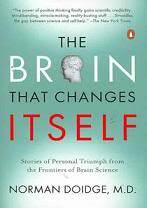Stories of Personal Triumph from the Frontiers of Brain Science
by Norman Doidge, M.D.
Patrick Garnett, SMART Recovery® Volunteer Facilitator & Regional Coordinator (IL)
 If you are new to recovery you have probably wondered, is it really possible to change? In “The Brain That Changes Itself,” we learn the answer is a resounding yes. Dr. Doidge, a Canadian psychiatrist and award-winning science writer, recounts the accomplishments of neuroscientists involved in neuroplasticity by sharing with us eleven examples demonstrating how the human brain is extremely malleable, well into old age.
If you are new to recovery you have probably wondered, is it really possible to change? In “The Brain That Changes Itself,” we learn the answer is a resounding yes. Dr. Doidge, a Canadian psychiatrist and award-winning science writer, recounts the accomplishments of neuroscientists involved in neuroplasticity by sharing with us eleven examples demonstrating how the human brain is extremely malleable, well into old age.
Doidge highlights how our brain is a system of processors that process data from our senses and how these processing centers change and adapt based upon the data that enters. We learn how certain brain exercises can offer radical improvement in cognitive functioning in how we learn, think, perceive and remember, and that these improvements are even possible in the elderly.
Changing our behaviors, unlearning a response and learning a new behavior is very possible, but it takes hard work and practice. The more we have repeated our bad habits, the more space in the brain they claim, thus making it harder for a new habit to find space. It is a process. The saying that you didn’t become addicted overnight, and that it will take practice and patience to unlearn your addictive habits and replace them with good habits, is proven true.
Neurons that fire together, wire together, which gives us insight into how and why certain stimuli or triggers can create an urge to use. You will learn that neurons that fire apart, wire apart, explaining why urges become less frequent, less intense and easier to resist the longer you abstain from using.
Doidge goes into detail as to why internet porn addiction has become an epidemic in the US and why watching internet porn quickly becomes addictive by high-jacking your normal dopamine release. While pornographers promise healthy pleasure and relief from sexual tension, what they often deliver is an addiction, tolerance and an eventual decrease in pleasure. Users develop new maps in their brains based upon photos and videos. And because our brains are a use-it-or-lose-it system, these brain maps long to keep activated, hence the urges.
The author also covers how we can use our brain’s plasticity to stop worries, obsessions, compulsions and bad habits. We learn how we can shift our brain out of the obsessive thought patterns by focusing on a new, pleasurable activity. The key is to realize that the more you focus on the content of the obsession the worse the condition becomes. It is essential to DO something to “shift” the gear manually. This could even include doing meditation or deep-breathing.
There is not much difference, in our brain, between imagining an act and doing it. We learn that there is actually a materialistic change in the brain when we think. This is why it is of the utmost importance for us to not “play” with thoughts of using, such as remembering the “good old days,” and instead visualize what we are hoping to accomplish.
In another story, Doidge discusses how psychotherapy can actually help to reorganize the brain. So for those of you who may have passed on psychotherapy, thinking it was of no use, you may want to reconsider.
At this point, you are probably thinking all this sounds very exciting and hopeful, which it is; but there is also the other side of our brain’s plasticity. This feature can also cause us to become more rigid in our behavior, rather than fluid. The more we repeat a behavior, the deeper the grooves in the record become. The brain is actually so malleable it is quite vulnerable to its surroundings. Television and the internet are creating significant impact to our brains, leading to various disorders in today’s young, such as ADHD. .
Doidge shows how physical exercise and learning are key to keeping the brain fluid and healthy. Exercise helps produce new brain stem cells and learning prolongs their survival. And when learning new skills, paying close attention and focusing is essential to long-term change. Doidge’s book is a fascinating read and reminds us that everything we think, feel and do matters. So for those of us in recovery, having a well-structured recovery plan is highly-advisable.
“The Brain that Changes Itself: Stories of Personal Triumph from the Frontiers of Brain Science”
by Norman Doidge, M.D.
(Penguin Publishing ISBN: 0143113100)
